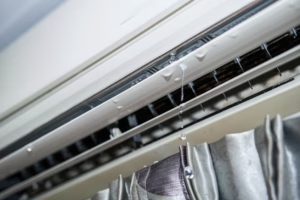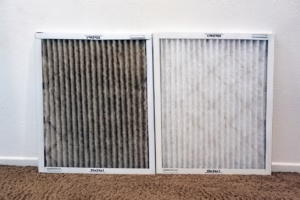As temperatures rise, your air conditioner works hard to keep your home cool and comfortable. But if you’ve noticed water pooling around your AC unit, it’s more than just an inconvenience, it’s a warning sign you shouldn’t ignore. Left unchecked, AC leaks can lead to costly damage to your floors, walls, and furniture, not to mention higher energy bills.
The good news? Most AC water leaks are preventable — and fixable. To help you stay ahead of the issue, we’ve outlined the most common causes of air conditioner leaks, how your system handles moisture, and what you can do to both resolve current issues and prevent future ones. Whether you’re troubleshooting a problem or simply want to protect your home and cooling system, our guide can help you keep your home cool, efficient, and protected all season long.
How AC Systems Create Water and Why It Leaks
Water production happens naturally during your air conditioner’s normal operation. Warm, humid air from your home contacts the cold evaporator coils, causing moisture to condense. This condensation process actually removes excess humidity from your indoor air, creating the comfortable environment you expect.
The collected moisture drips into a shallow tray called the condensate drain pan. From there, water travels through a PVC drain line that carries it either outside your home or to an interior drain connection. A properly functioning air conditioner produces between 5 and 20 gallons of water daily, depending on humidity levels and system usage.
Water dripping outside your home signals normal operation. Water appearing inside means something has gone wrong. Your air conditioning system’s moisture management works reliably when all components function correctly. Problems arise when any single element in this chain fails, redirecting water from its intended path into your living space.

8 Common Reasons Your AC Unit Is Leaking Water
Water leaks from air conditioning units rarely happen without warning signs. Most homeowners contact us after noticing puddles, but the underlying causes often develop gradually over months or years. Here’s what we typically find during service calls:
- Clogged Drain Line: The most frequent culprit we encounter. Algae, dirt, and debris accumulate in the drain line, preventing water from properly exiting your system. Water backs up and overflows from the drain pan when this pathway becomes blocked.
- Rusted or Cracked Drain Pan: Drain pans endure constant moisture exposure and temperature fluctuations. After years of service, they develop cracks, rust, or corrosion. Collected condensation then leaks directly into your home rather than flowing to the drain line.
- Frozen Evaporator Coil Leak: The coil freezes due to restricted airflow or refrigerant issues, then produces excessive water when thawing — more than the drain system can handle.
- Dirty Air Filter Water Leaks: Homeowners often overlook this simple maintenance task. Clogged filters restrict airflow over the evaporator coils, causing them to freeze. Excess water leaks from your unit when the coils eventually thaw.
- Low Refrigerant HVAC Leak: Insufficient refrigerant creates pressure drops within your system, leading to frozen evaporator coils. The melting ice causes leakage problems that won’t resolve until refrigerant levels are restored.
- Broken Condensate Pump: Systems installed in basements or attics typically include pumps to move water upward. Mechanical failure prevents proper water removal, causing overflow.
- Improper Installation: We sometimes discover units with incorrect positioning or improper component connections. These installation errors create ongoing moisture management problems.
- Damaged Insulation: Compromised insulation around refrigerant lines increases condensation within your system, potentially leading to water leaks. This problem often goes unnoticed until significant damage occurs.

How to Fix and Prevent AC Water Leaks
Water leaks require immediate attention to protect your home and equipment. Shut down your system completely at both the thermostat and circuit breaker before attempting any repairs. This safety step prevents additional leakage and protects electrical components from damage.
Simple drain line clogs often respond to home remedies. Pour one cup of white vinegar into the drain line access point and allow 30 minutes for the solution to break down buildup before flushing with clean water. Use a wet/dry vacuum connected to the exterior drainpipe to suction out accumulated debris.
Preventive maintenance stops problems before they start. Air filter replacement every 1-3 months maintains adequate airflow and prevents coil freezing issues. Drain pans deserve regular inspection for cracks or corrosion, particularly on systems approaching 12-15 years of age. Float switches provide valuable protection by automatically shutting down your system when water levels rise, preventing extensive property damage.
Minor drain pan cracks can be sealed temporarily with water-resistant compounds, though severely damaged pans require full replacement. Failed condensate pumps need immediate replacement to prevent water accumulation in basements or attic spaces.
Certain situations require professional intervention. Refrigerant leaks, significant water damage, or persistent problems despite proper maintenance indicate the need for expert diagnosis.
Contact Us
Proactive care today prevents expensive repairs tomorrow. If your system is still leaking after attempted fixes, or you’re dealing with refrigerant problems or major component failures, it’s time to bring in the pros. Our experienced team at Progressive Air can pinpoint the root of the issue and get your AC back on track. Contact us to schedule a thorough system inspection and ensure your cooling equipment operates reliably through the demanding summer season.

